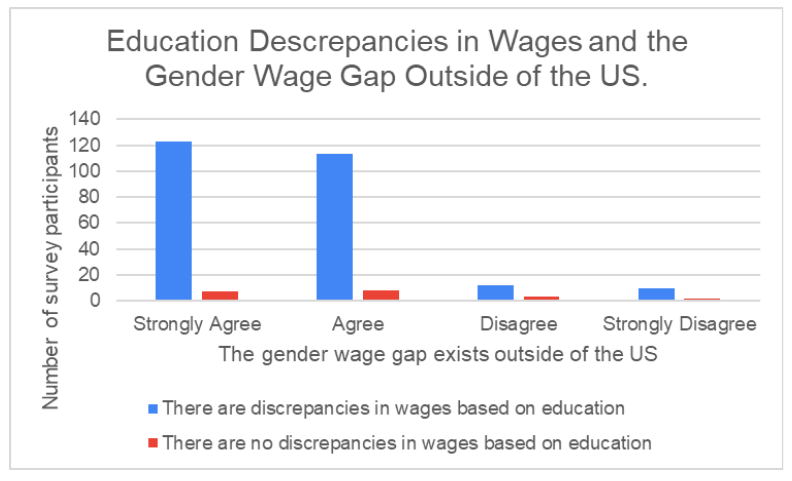Price of Gender Research Essay
Taylor Lamson
Dr. Colleen James
GNDR 3635
11/27/21
Personal Beliefs About the Gender Wage Gap Outside of the USA and
Discrimination in Wages Based on Education
Question
My hypothesis was that our survey would show a correlation between those who said they believe the gender wage gap exists outside of the United States and those who believe education affects wages. I wanted to focus on this question because I was interested in how the gender wage gap interacts with the agricultural field. I thought that the best way to look at that through our particular study would be to look at the wage gap outside the USA and educational discrepancy variables together since we had no questions directly relating to agriculture.
Visual Representation

X^2(2, N=278) = 5.996, p = .111805

Methods
To gather this data we sent out a survey to personal friends and family. We also advertized the survey on Reddit, to any respondents who saw it within the timeframe we allowed. However, because of the low numbers of survey respondents and the limited groups of people that made up the majority of our respondents, our data in most categories was concentrated towards certain answers. I separated out the data by those who included “education” in their answers for what causes discrepancies in wages, and those who did not.
This is partially due to the low numbers in the data–without combining these answers most categories would only have had one or two respondents in them. After that, I combined our positive (agree/strongly agree) answers and our negative (disagree/strongly disagree) answers and made a simple bar chart to display our responses. Finally, I ran a chi-squared test to determine if there was any correlation between the two variables of my hypothesis. This test returned no statistical significance, determining that my hypothesis for this survey was incorrect.
Verbal Representation/Context and Discussion
My results ended up not being significant, disproving my hypothesis. I believe this is, in part, because of our condensed survey answers and more data would be needed for further analysis.
Another variable that could be added to this analysis would be income levels–but again, those are likely to be skewed for this particular survey. This would take into account poverty levels in relation to gender, as examined in “Rwanda’s gendered agricultural transformation: A mixed-method study on the rural labour market, wage gap and care penalty” by Bigler, C., Amacker, M., Ingabire, C., & Birachi, E.
In an article written by Molina Tejerina, O. J., & Bobka Calcina, S., titled “International trade and unexplained gender wage gaps: Evidence for agricultural sector in Bolivia,” the researchers’ hypothesis was that gender discrimination in the Bolivian agricultural market is based purely on person preference. Because this article is an argument article, it would be interesting to conduct a survey similar to this one and see if our answers changed at all. Because our survey asked a number of “opinion” questions, it would help determine people’s preexisting opinions and, given their status, how that may or may not lead to personal discrimination in the agricultural market.
Looking at Bui, M. T. T., & Permpoonwiwat, C. K.’s article “Gender wage inequality in Thailand: A sectoral perspective” and Rebecca Glauber’s article “Trends in the motherhood wage penalty and the fatherhood wage premium for low, middle, and high earners” is a great way to compare how the gender wage gap looks outside of the USA versus inside.
Both articles show that in Thailand and in the USA, the gender wage gap is steadily decreasing. While the gender wage gap is decreasing in both areas, it has not disappeared entirely in either. In order to bring this idea into a future survey, we would need to ask a question about people’s beliefs about how the gender wage gap has changed both inside and outside of the USA and what people believe the similarities or differences are.
Mahajan, K., & Ramaswami, B. reexamined a study about how caste in India affects the gender wage gap; “Caste, female labor supply, and the gender wage gap in India: Boserup revisited.” This brings in another interesting variable that we did not examine in our USA-based survey, which is predetermined class.
In the USA, your class status is usually determined entirely by the accumulation of wealth or the type of job field. When I was researching the gender wage gap and agrarianism, class or societal standing was not usually a variable in these studies because most were conducted exclusively on laborers or people of the same societal standing. Because India has a caste system, this adds another possible variable to explain the wage gap outside of gender.
In the survey-based study conducted by Pannilage, U., “A socio-economic analysis on the gender wage gap among agricultural laborers in rural Sri Lanka,” the researcher determined that age and education level were not factors in the gender wage gap seen in the Southern Dry Zone. This case creates a heavy contradiction to our data, wherein the majority of people answered that they believe education does affect wages.
Because this survey was conducted inside of the USA, there is the possibility that our survey respondents are expressing that they believe education is a factor in determining wages inside the USA, but our question would need to be reworded to determine this for sure. If our survey participants did indeed believe that the gender wage gap outside of the USA and levels of education are connected, this study would directly contradict that.
I would like to ask our survey participants these questions again to directly determine what they mean and give them the same survey again after presenting them with this information to determine if anyone has changed their minds. I would hypothesize that most people would keep their answers the same after being presented with only one contradiction, but it would still be interesting to see.
I chose not to focus on race for this analysis because most (if not all) of this analysis was conducted inside of the USA. Racial issues present differently outside of the USA. For example, our survey wouldn’t make sense to a country that deals with xenophobia as their primary form of racism, since our questions focus on ethnicity and not origin. I also chose not to focus on disability because the studies that I could find focusing on disability and wages outside of the US did not have a gender component.
The study done by Sophie Mitra, titled “Wage differential by disability status in an agrarian labour market in India,” would be an excellent study to add a gender variable too. This study focuses entirely on men but examines the disability wage gap in India’s agricultural market.
Though my results proved to have no statistical significance, I believe that with more information we could more accurately determine if there is a correlation between people’s beliefs about education-based wage discrimination and the gender wage gap outside of the USA.

